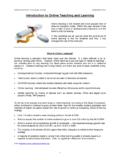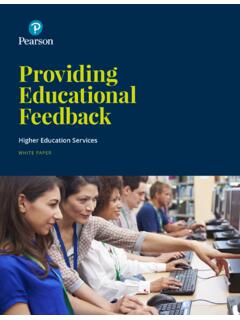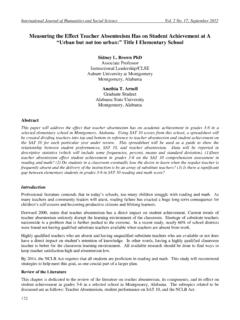Transcription of Teacher wellbeing and its impact on student learning
1 Teacher wellbeing and its impact on student learning Donna Cross Winthrop Professor Telethon Kids Institute The University of Western Australia In one day we not only teach, we manage behaviour, plan lessons, assess learning , counsel students, carry out first aid, reply to a long list of emails, write reports, tidy classrooms, create resources, mark books and create displays the list is endless. ( Teacher , 2013). Australian newspaper headlines Australian newspaper headlines Prevalence Teachers report the highest level of occupational stress in Australia, the United Kingdom and America (Bailey, 2013;. Education, 2014; Milburn, 2011). Prevalence In Australia, 41% of teachers report high levels of occupational stress (Milburn, 2011).
2 Teachers make more mental stress claims than any other industry (WorkCover, 2014). Nearly 40% of Australian school principals report feeling stressed or bullied (Michael, 2013). 46% of 7,200 K-12 teachers surveyed in the United States reported feeling stressed daily (Education, 2014). A survey by the National Union of Teachers in the United Kingdom found 81% of teachers experienced depression, anxiety, or stress at work (" Teacher Stress," 2012). Principals Australian studies show that school principals feel overwhelmed by their workloads. They are stressed by expectations and the lack of administrative support in schools, Teacher shortages, and dealing with parents (Tomazin, 2008). Violence and threats One-third of school principals experience an incident of physical assault, 6 times higher than other workers (Milburn, 2012).
3 Most attacks or threats coming from parents, with principals in rural locations most at risk (Michael, 2013). Causes of stress - Teachers Sources of high levels of Teacher stress: workload, workplace conditions and climate, and expectations. In particular: excessive workload and working hours poor student behaviour including lack of motivation and effort, disrespect, violence, challenging authority management of bullying, and reactive management strategies aggression from pupils and parents classroom and school climate Causes of stress - Teachers Pressures of assessment targets and inspections Conflict with management and colleagues Adapting and implementing new curriculum Teaching efficacy and learning new skills Self-esteem and status False public perceptions that teachers Lack of professional opportunities Lack of involvement at the decision making level of educational reforms (Clunies Ross, Little, & Kienhuis, 2008.)
4 Kyriacou, 2001; Pillay, Goddard, & Wilss, 2005; " Teacher Stress," 2012; Boyle, Borg, Falzon, & Baglioni, 1995; Geving, 2007;. Grayson & Alvarez, 2008; Hastings & Bham, 2003; Howard & Johnson, 2004;. Kokkinos, 2007; Naghieh, Montgomery, Bonell, Thompson, & Aber, 2013;. WorkCover, 2014). Early Career Teachers Early Career Teachers The stress and burnout process may begin as early as the student -teaching experience. student teachers who experienced high guidance demonstrated lower levels of burnout at the end of their practicum than those who experienced low guidance (Fives, Hamman, & Olivarez, 2007). The attrition rate among early career teachers is 50% (Marshal, 2013a; Allen, 2005; Livingstone, 2007).
5 Early Career Teachers More than one-in-four Australian teachers suffer from emotional exhaustion after starting their careers and expect to leave the profession within the first five years of teaching ("Let us teach," 2007; Marshal, 2013b; Milburn, 2011). Reasons for stress and burnout include: New practices not accepted widely by peers;. Feeling isolated;. Low morale;. Given toughest classes;. Lack of administrative support; and Much tougher emotional conditions than they expected. (Marshal, 2013a). Early Career Teachers A recent study has found the quality of collegial support and opportunities for professional learning encourage early career teachers. student engagement and behaviour management, workload and physical, geographic, professional, and emotional isolation are causes of considerable concern to early career teachers, particularly in their first year of teaching.
6 (Buchanan et al., 2013). Workplace bullying Causes of stress Workplace bullying 2008-2010, 300 NSW teachers and education department staff won compensation claims for workplace bullying (Jones, 2011). In a survey of over 800 Australian teachers in government, Catholic and independent schools: almost all ( ) teachers reported that they had been bullied at school by fellow teachers, principals or parents more than 90% of teachers reporting that they had been bullied by colleagues (Allen & Chilcott, 2009; Davis, 2007; McDougall, 2007). Causes of stress Workplace bullying Bullying took the form of: unmanageable workloads being ignored or excluded from decision-making having their integrity undermined losing or gaining responsibilities without consultation having personal property attacked physical abuse, threats of violence Most likely to be targeted by school executive staff, followed by colleagues, principals and parents (Allen & Chilcott, 2009; Davis, 2007; McDougall, 2007).
7 Causes of stress Workplace bullying 2009-2010, 154 workers compensation claims were lodged by West Australian teachers as victims of assaults for being struck, bitten, kicked, punched, pushed, head-butted or spat on by students (Phillips, 2011a). Protective factors Factors identified as protective against Teacher stress and burnout: resources to increase sense of self-efficacy connectedness with students and colleagues supported by colleagues receiving recognition for their work (Klassen, Perry, & Frenzel, 2012; Flook et al 2013; Gardner 2010; Schwarzer & Hallum, 2008). Consequences of stress Stress is related to different work outcomes eg: workplace engagement, job satisfaction and attrition. Almost 70% of teachers do not feel engaged in their work Affects their teaching, their ability to be responsive and successfully perform their role, and their relationships with students and parents (Education, 2014; Flook et al.)
8 , 2013; S Yoon, 2002; " Teacher Stress," 2012;. Turkson, 2004). Consequences of stress One-third of Australian teachers indicated they intend to leave the profession within the next 3 years (Clarke, 2005). The personal consequences of Teacher stress can include absence, burnout, physical and emotional distress, reduced self con dence and self-esteem, damaged personal relationships and suicide (Gardner, 2010; Howard & Johnson, 2004; Mearns & Cain, 2003; " Teacher Stress," 2012). Consequences of stress Prolonged stress may lead to the emotional exhaustion that characterises burnout (Naghieh et al., 2013). A signi cant loss of skilled and experienced teachers through those choosing to leave the profession (Howard & Johnson, 2004.
9 Mearns & Cain, 2003). A half to two-thirds of teachers have considered leaving the profession due to stress (Milburn, 2011; Phillips, 2011b; Simos, 2011;. " Teacher Stress," 2012). Reasons: not feeling part of the school community; poor communication between staff and management; school principal was not approachable;. highly stressful working conditions; harassment, discrimination or workplace bullying; and the lack of administrative support. Teacher stress and student learning Poor Teacher engagement impacts student engagement levels (Education, 2014). Emotionally exhausted teachers may use reactive and punitive responses that contribute to negative classroom climates and student - Teacher relationships (Osher et al 2007; Yoon 2002).
10 Patterns of student misbehaviour and Teacher stress can form a cycle that is difficult to interrupt (Yoon 2002). Quality of relationships with peers/teachers and positive versus negative school experiences student connectedness (Bond et al 2007). Poor school connectedness results in poorer academic and mental health outcomes for students (Bond et al 2007). The way people hurt each other has evolved . Building a positive school culture . Cyber Strong Schools website: Introduction Five modules Teaching and learning Whole School Policy Professional Conduct Developing Personal Knowledge student Cyber Leaders Teaching and learning What is my role as an educator? Teaching and learning Online resources available to be used within the classroom Whole School Policy Scenario 1: Teacher X recently attended a professional learning seminar about creating a digitally rich classroom.









